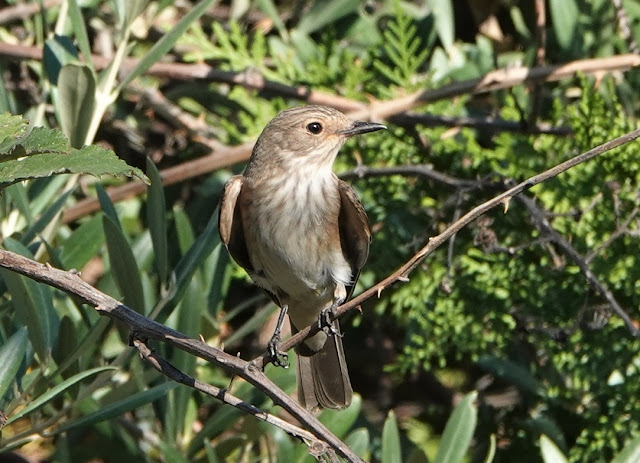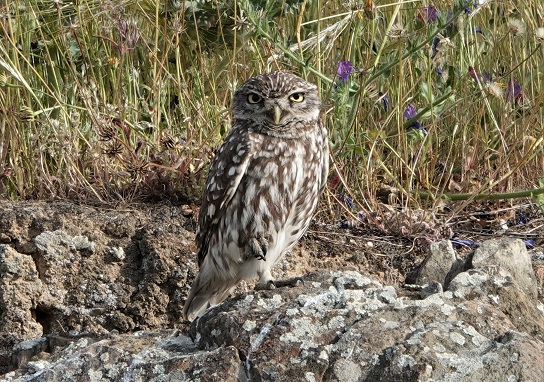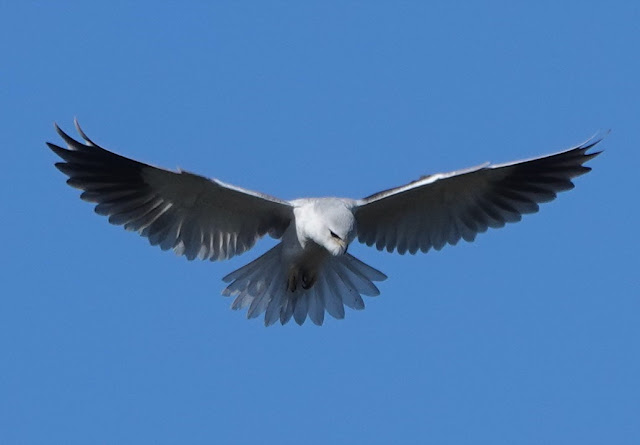A young master at work
 |
| Spotted Flycatcher (Martin Kelsey) |
This is flycatcher month in Extremadura. Fresh from broad-leaved forests in central and northern Europe, Pied Flycatchers are the most abundant. With their urgent, metallic alarm call, they are easy to locate and on my regular walk along the lane from the house I can expect to find five or six in the space of twenty minutes. At this time of year, all are in plumages similar to that of spring females, a satin brown above with whitish underparts and a bold white flash on the wing. The males are no longer the striking "pied" black and white excitements of spring. My morning's tally in September will exceed the total number of spring passage birds that I will see in a normal year here. There are several reasons for this. The numbers of migrant birds will always be greater in the autumn than the spring because the population is larger - there being adults and young birds on the move. In spring, one sees only those birds that have survived the migration route there and back. Autumn migration is often more relaxed, with birds staying for longer at their staging points en route. But with Pied Flycatchers there is also another factor. The southward route they take in the autumn is different. The reason I see so few in the spring is that most are migrating much further to the east. After the breeding season, they loop down on a more westerly front.
 |
| Pied Flycatcher (John Hawkins) |
They are engaging little birds. Early one morning recently, I stood close to an old dry-stone wall marking the boundary of an abandoned olive grove. There was a pack of Sardinian Warblers, clearly agitated. I got the feeling that I was not their concern, and true enough a cocky little Weasel lolloped along the top of the wall towards me, pausing when registering me and then snuffling down in between the stones. On a branch just above it a vigilant Pied Flycatcher repetitively gave its alarm whilst simultaneously raising one wing as if flagging a staccato signal.
 |
| Spotted Flycatcher (Martin Kelsey) |
The plainer Spotted Flycatchers are fewer in number. For the last two days, a young bird has adopted a corner of our garden as its stopover. The scientific species name for it striata, is a more accurate description of its appearance, being finely streaked on the head and breast rather than spotted. The pale tips of the wing coverts, forming a wing bar, told me that this bird was on its very first migration. It is making this journey entirely on its own. Somehow, almost miraculously, an internal genetic message makes connection with the position of a star, Polaris, 433 light years away and this bird's brain calculates angle of inclination and time to check its solitary nocturnal flight. Countless generations worth of inheritance, lodged in its genes will also tell it when to stop, in some Sahelian thicket on the other side of a two-thousand kilometres crossing of the Sahara. All on its own.
In the meantime it had found our garden. Each afternoon it has perched on a couple of bramble twigs in a dappled corner where a column of midges gathers, lit up by a shaft of sunlight. In exemplary flycatcher fashion, it makes sallies from the perch, returning to the same spot. These short flights vary. Some are downward sweeps, curving and then rising back to the perch. Others strike out horizontally, with a bank and swerve to return. I have also watched it rise vertically, perhaps to ten metres from the ground, before a sharp descent to the twig. On the first afternoon, it was averaging a sally every 25 seconds. It was there for at least an hour and 55 minutes. During that time it had probably made 276 flights. The success rate was impossible to estimate, given the prey items were so small, but sometimes I heard a snap of the bill closing quickly. On such occasions I suspect the insect, caught up in the stiff bristles close to the base of the bill, had found its way into the flycatcher`s gape. The bird had earned its name.
 |
| Spotted Flycatcher (Martin Kelsey) |
This young Spotted Flycatcher was not the only bird attracted to these midges. A crowd of Red-rumped Swallows took turns to make individual sorties, gliding across my view and fluttering to swivel and take an insect. They accompanied these manoeuvres with delighted chortles. Curiously absent on the first afternoon, other species had come on board by the second. House Sparrows ungainly but gameful, plunged into space, poorly equipped to catch these tiny insects. A Blue Tit tried its luck, flying upwards in a flurry of wingbeats. More impressive were the attempts of a Stonechat, learning to use a single lookout and masterly sweeping glides almost as impressively as its model. Perhaps it was fanciful, but it seemed that the Spotted Flycatcher had started a trend.



Comments